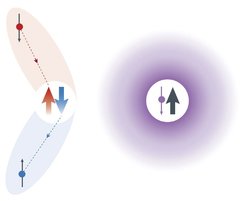Pressemeldung: The challenge of heavy fermions
Strong electronic correlations in solids may result in fascinating phenomena like unconventional superconductivity and quantum criticality in heavy fermion metals. The latter provide a particularly promising playground to explore the coexistence and competition of different phases as much as the emergence of novel phases. As such, research on heavy fermion materials continues to thrive at the forefront of solid state physics while challenging our understanding. This issue becomes immediately obvious upon comparing the phase diagrams of such heavy fermion materials that exhibit superconductivity around a so-called quantum critical point with such highly discussed superconductors like the cuprates, iron-based or organic superconductors which share a number of commonalities. Hence, albeit heavy-fermion research is certainly mostly fundamental in nature, it may help paving the way for important applications by providing clues for future materials design for, e.g., exploiting superconductivity or thermoelectrics.
The present review gives some introductory perspective into the development of the field of strongly correlated electron systems over the past four decades. Special emphasis is laid on the Kondo effect (see figure) in competition with magnetic order which may give rise to quantum critical phenomena. Improvements to several experimental methods provided new insight into the physics of heavy fermion systems in recent years (including magnetic quantum oscillations and scanning tunneling microscopy) which, along with established electronic and thermal transport measurements, allow to draw a picture from macroscopic to microscopic length scales. On the other hand, progress on the theoretical understanding of such systems helped developing a more generalized phase diagram by recognizing the impact of quantum fluctuations. The recent advance of heavy fermion semiconductors is also highlighted.
Nature Reviews Materials is the first physical sciences journal in the Nature Reviews family and was launched at the beginning of this year.
Publication: S. Wirth and F. Steglich, Nat. Rev. Mat. 1 (2016) 16051.
SW / CPfS

Schematic representation of the single-impurity Kondo effect. Left: It originates from the spin-exchange scattering (red to blue) where the total spin of the scattered conduction electron (small dots) and of the localized d or f electron (big arrows) is conserved. Right: Upon cooling, the effective coupling strongly increases such that the localized spin (indicated by the thick black arrow) is increasingly screened by the conduction electrons (which have a total spin represented by the thin purple arrow). The superposition of Kondo singlets describes the non-magnetic ground state of the Kondo impurity.
